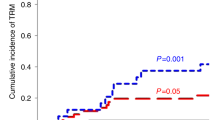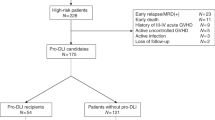Abstract
Haploidentical hematopoietic stem cell transplantation (haplo-HSCT) is an alternative for patients who need a transplant without having conventional donors. One hundred and five consecutive patients with hematologic malignancies who underwent G-CSF-primed peripheral blood haplo-HSCT without in vitro T-cell depletion in our single center were reported in this study. Patients were categorized into the intermediate-risk group (n=28) or high-risk group (n=77) according to the risk stratification. The conditioning regimen included fludarabine, busulfan, cyclophosphamide and anti-lymphocyte globulin. The cumulative incidence of grades II-IV acute GvHD (aGvHD) on day +100 was 21.9%, and that of grades III-IV aGvHD was 14.3%. The 2-year cumulative incidence of total chronic GvHD (cGvHD) was 24.1%, and that of extensive cGvHD was 5.6% in 83 eligible patients. The 3-year cumulative incidence rates of relapse and no relapse mortality were 21.9% and 30.5%, respectively. After a median follow-up of 35 months, the 3-year probabilities of overall and disease-free survival for the intermediate-risk and high-risk groups were 63.2% and 39.8% and 61.2% and 32.2%, respectively. In multivariate analysis, the outcome of survival (overall survival and disease-free survival) was associated with the risk stratification, disease status at transplant and dose of infused mononuclear cells. Our results suggest that unmanipulated peripheral blood stem cell allograft performed with fludarabine, busulfan, cyclophosphamide and anti-lymphocyte globulin conditioning regimen is feasible.
This is a preview of subscription content, access via your institution
Access options
Subscribe to this journal
Receive 12 print issues and online access
$259.00 per year
only $21.58 per issue
Buy this article
- Purchase on Springer Link
- Instant access to full article PDF
Prices may be subject to local taxes which are calculated during checkout




Similar content being viewed by others
References
Huang XJ . HLA-mismatched/haploidentical hematopoietic stem cell transplantation: a field in which Chinese doctors are making great contributions. Chin Med J 2010; 123: 1235–1240.
Foeken LM, Green A, Hurley CK, Marry E, Wiegand T, Oudshoorn M . Monitoring the international use of unrelated donors for transplantation: the WMDA annual reports. Bone Marrow Transplant 2010; 45: 811–818.
Lu DP, Dong L, Wu T, Huang XJ, Zhang MJ, Han W et al. Conditioning including antithymocyte globulin followed by unmanipulated HLA-mismatched/haploidentical blood and marrow transplantation can achieve comparable outcomes with HLA-identical sibling transplantation. Blood 2006; 107: 3065–3073.
Kekre N, Antin JH . Hematopoietic stem cell transplantation donor sources in the 21st century: choosing the ideal donor when a perfect match does not exist. Blood 2014; 124: 334–343.
Aversa F, Tabilio A, Terenzi A, Velardi A, Falzetti F, Giannoni C et al. Successful engraftment of T-cell-depleted haploidentical "three-loci" incompatible transplants in leukemia patients by addition of recombinant human granulocyte colony-stimulating factor-mobilized peripheral blood progenitor cells to bone marrow inoculum. Blood 1994; 84: 3948–3955.
Luznik L, O'Donnell PV, Symons HJ, Chen AR, Leffell MS, Zahurak M et al. HLA-haploidentical bone marrow transplantation for hematologic malignancies using nonmyeloablative conditioning and high-dose, posttransplantation cyclophosphamide. Biol Blood Marrow Transplant 2008; 14: 641–650.
Aversa F, Terenzi A, Tabilio A, Falzetti F, Carotti A, Ballanti S et al. Full haplotype-mismatched hematopoietic stem-cell transplantation: a phase II study in patients with acute leukemia at high risk of relapse. J Clin Oncol 2005; 23: 3447–3454.
Wang Y, Liu DH, Liu KY, Xu LP, Zhang XH, Han W et al. Long-term follow-up of haploidentical hematopoietic stem cell transplantation without in vitro T-cell depletion for the treatment of leukemia: nine years of experience at a single center. Cancer 2013; 119: 978–985.
Bethge WA, Faul C, Bornhauser M, Stuhler G, Beelen DW, Lang P et al. Haploidentical allogeneic hematopoietic cell transplantation in adults using CD3/CD19 depletion and reduced intensity conditioning: an update. Blood Cells Mol Dis 2008; 40: 13–19.
Huang XJ, Liu DH, Liu KY, Xu LP, Chen H, Han W et al. Treatment of acute leukemia with unmanipulated HLA-mismatched/haploidentical blood and bone marrow transplantation. Biol Blood Marrow Transplant 2009; 15: 257–265.
Armand P, Gibson CJ, Cutler C, Ho VT, Koreth J, Alyea EP et al. A disease risk index for patients undergoing allogeneic stem cell transplantation. Blood 2012; 120: 905–913.
Armand P, Kim HT, Zhang MJ, Perez WS, Dal Cin PS, Klumpp TR et al. Classifying cytogenetics in patients with acute myelogenous leukemia in complete remission undergoing allogeneic transplantation: a Center for International Blood and Marrow Transplant Research study. Biol Blood Marrow Transplant 2012; 18: 280–288.
Armand P, Deeg HJ, Kim HT, Lee H, Armistead P, de Lima M et al. Multicenter validation study of a transplantation-specific cytogenetics grouping scheme for patients with myelodysplastic syndromes. Bone Marrow Transplant 2010; 45: 877–885.
Przepiorka D, Weisdorf D, Martin P, Klingemann HG, Beatty P, Hows J et al. 1994 Consensus Conference on Acute GvHD Grading. Bone Marrow Transplant 1995; 15: 825–828.
Gray R . A class of K-sample tests for comparing the cumulative incidence of a competing risk. Ann Stat 1988; 16: 1141–1154.
Wang Y, Liu DH, Xu LP, Liu KY, Chen H, Chen YH et al. Superior graft-versus-leukemia effect associated with transplantation of haploidentical compared with HLA-identical sibling donor grafts for high-risk acute leukemia: an historic comparison. Biol Blood Marrow Transplant 2011; 17: 821–830.
Slavin S, Nagler A, Naparstek E, Kapelushnik Y, Aker M, Cividalli G et al. Nonmyeloablative stem cell transplantation and cell therapy as an alternative to conventional bone marrow transplantation with lethal cytoreduction for the treatment of malignant and nonmalignant hematologic diseases. Blood 1998; 91: 756–763.
Wu BY, Guo KY, Song CY, Yang Li D . Mixed chimera converted into full donor chimera with powerful graft-versus-leukemia effects but no graft-versus-host disease after non T-cell-depleted HLA-mismatched peripheral blood stem cell transplantation. Bone Marrow Transplant 2000; 26: 691–693.
Raiola AM, Dominietto A, Ghiso A, Di Grazia C, Lamparelli T, Gualandi F et al. Unmanipulated haploidentical bone marrow transplantation and posttransplantation cyclophosphamide for hematologic malignancies after myeloablative conditioning. Biol Blood Marrow Transplant 2013; 19: 117–122.
Grullich C, Ziegler C, Finke J . Rabbit anti T-lymphocyte globulin induces apoptosis in peripheral blood mononuclear cell compartments and leukemia cells, while hematopoetic stem cells are apoptosis resistant. Biol Blood Marrow Transplant 2009; 15: 173–182.
Finke J, Bethge WA, Schmoor C, Ottinger HD, Stelljes M, Zander AR et al. Standard graft-versus-host disease prophylaxis with or without anti-T-cell globulin in haematopoietic cell transplantation from matched unrelated donors: a randomised, open-label, multicentre phase 3 trial. Lancet Oncol 2009; 10: 855–864.
Chang YJ, Zhao XY, Huang XJ . Immune reconstitution after haploidentical hematopoietic stem cell transplantation. Biol Blood Marrow Transplant 2014; 20: 440–449.
Acknowledgements
We acknowledge the great contributions of the nurses, physicians and laboratory staff from the department of hematology of Zhujiang Hospital of Southern Medical University of China to patient care. This work was supported by the Scientific and Technology Programs of Guangzhou of China (NO: 2011Y1-00033-3).
Author information
Authors and Affiliations
Corresponding author
Ethics declarations
Competing interests
The authors declare no conflicts of interest.
Rights and permissions
About this article
Cite this article
Lin, X., Lu, Z., Song, C. et al. Long-term outcome of HLA-haploidentical hematopoietic stem cell transplantation without in vitro T-cell depletion based on an FBCA conditioning regimen for hematologic malignancies. Bone Marrow Transplant 50, 1092–1097 (2015). https://doi.org/10.1038/bmt.2015.108
Received:
Revised:
Accepted:
Published:
Issue Date:
DOI: https://doi.org/10.1038/bmt.2015.108
This article is cited by
-
Antithymocyte globulin improves the survival of patients with myelodysplastic syndrome undergoing HLA-matched unrelated donor and haplo-identical donor transplants
Scientific Reports (2017)
-
How do we choose the best donor for T-cell-replete, HLA-haploidentical transplantation?
Journal of Hematology & Oncology (2016)
-
Long-term outcomes of HLA-haploidentical stem cell transplantation based on an FBCA conditioning regimen compared with those of HLA-identical sibling stem cell transplantation for haematologic malignancies
Bone Marrow Transplantation (2016)



